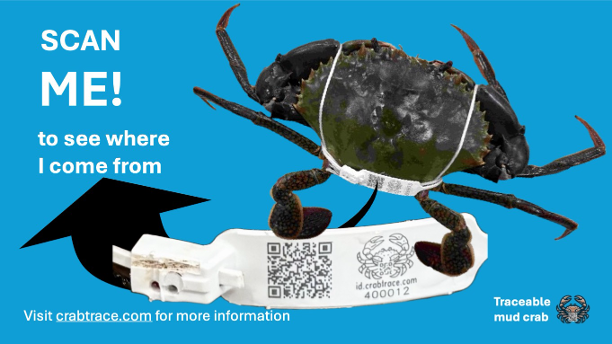Building a traceability data infrastructure to track provenance and quality in Australian seafood supply chains.

Leveraging IoT Technologies in Mud Crab Traceability
The integration of Internet of Things (IoT) technologies into everyday processes is revolutionizing industries worldwide. A prime example of this innovation is the Mud Crab Traceability Design project, which employs smart tagging and a comprehensive traceability data platform to enhance the traceability and management of mud crab fishing.
Smart Tagging with QR Codes
Among various smart tagging options such as RFID and NFC, QR codes have been selected for their unique blend of accessibility and efficiency. QR codes are not only cost-effective but also easy to generate and customize. They can be printed on various materials and are readable by any smartphone, making them extremely user-friendly.
Each mud crab is assigned a unique QR code, which links to a personalized webpage containing detailed traceability information. This information includes the crab’s catch date and time, the catch area displayed via Google Maps, and other relevant data like crab grade and geolocation, which can be transmitted via a mobile app.
Traceability Data Platform: A Closer Look
The traceability data platform is at the heart of this project. It serves different users from public scanners to fishing authorities, providing tailored data access:
• Public View: By scanning a crab’s QR code, anyone can access a webpage with comprehensive details about the crab’s origin, catch specifics, and even transport information. This transparency not only builds trust in the supply chain but also enhances consumer awareness about the source of their seafood.
• Fishers’ View: Fishers use a mobile app to manage their fishing activities, from pre-fishing preparations to post-catch management. They can register their fishing trips, customize their QR code tags, and even track their quota usage. This digital assistance helps in maintaining accurate logs that are essential for sustainable fishing practices.
• Authority View: Authorities can oversee and manage the catch data across various parameters. They have insights into everything from fisher profiles and fishing trips to detailed tag management. This data is crucial for regulating fishing activities and ensuring compliance with environmental standards.
Enhancing IoT Implementation
To further enhance the IoT framework, several developments can be considered:
1. Integration with Existing Apps: Linking the traceability system with existing apps like eFishers not only streamlines operations but also provides a familiar interface for users.
2. Advanced Tag Options: Exploring hybrid tagging solutions that combine QR codes with technologies like NFC could offer dual benefits, such as enhanced security and varied usability scenarios.
3. Data Analytics: Implementing advanced analytics on the collected data can provide predictive insights, helping to manage resources better and forecast market demands.
By embracing IoT technologies, the Mud Crab Traceability Design project not only improves the efficiency and transparency of mud crab fishing but also sets a benchmark for sustainable practices in the seafood industry.
Learn more about our technology
